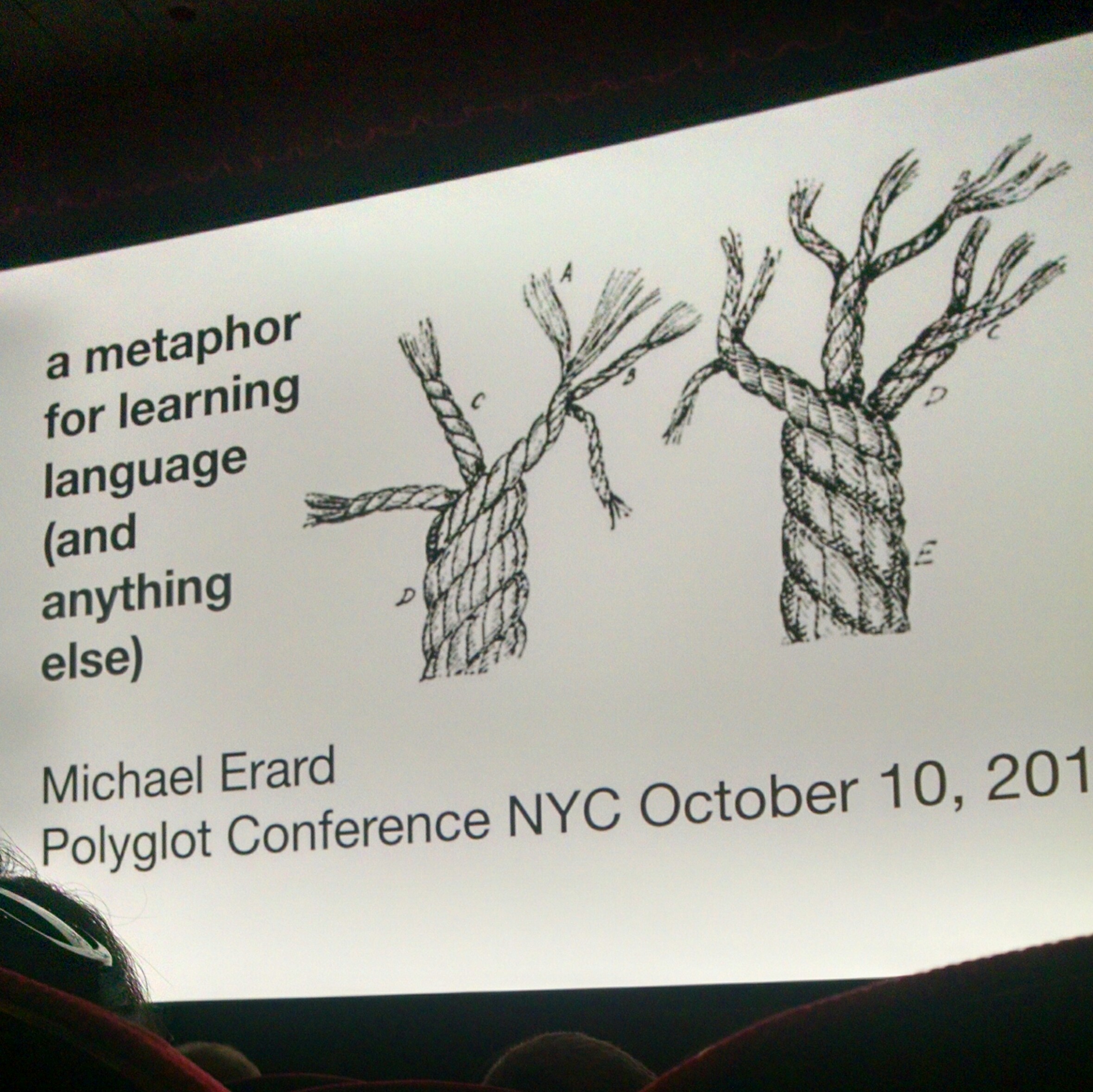Are You Weaving Your “Language Skill Rope”?
 Are you learning a language and weaving your "Language Skill Rope"?
Are you learning a language and weaving your "Language Skill Rope"?
In mid-October 2015, we attended the 3rd international Polyglot Conference in New York City. It was great! More than 400 language aficionados were there to mingle with. There were also a number of interesting talks on a wide range of language-related topics.
One talk I enjoyed a lot was by Michael Erard, the author of Babel No More: The Search for the World's Most Extraordinary Language Learners and other books about language and learning. He spoke about “A New Metaphor for Language Learning.”
According to Erard, a metaphor can shape the way you think and talk about a set of skills. For example, it can be helpful to:
• explain abstract or complex concepts
• conceive solutions to problems
• foster communication
• create familiarity
• trigger emotions
I also did not know that metaphors can actually be “designed.” It was fascinating to hear Erard talk about his five-year experience as a full-time metaphor designer at the FrameWorks Institute, a Washington think tank. Curious about that, and how the skill-rope metaphor was developed? You can find out more: Frameworks Research Report “Weaving Skill Ropes”
According to Erard, the metaphor of “weaving ropes” works well for learning language skills, specifically.
While the idea of a language learning metaphor did not resonate with me initially, I've since warmed up to it. I now find the “rope” metaphor actually quite useful. It's put my language skills into a new light. It also helps me understand how my awareness of language learning has changed since my childhood.
Language Learning from Child to Adult
 At different stages of life, we learn language differently - and also think about language learning differently.
At different stages of life, we learn language differently - and also think about language learning differently.
As children, we typically learn to speak our first (or second) language “naturally,” just by imitating our parents, caregivers, and friends and getting corrected by them. Watching my own and other children, it's obvious to me that they don't think much about what and how they're learning.
When we start with reading and writing in school, it becomes clear that we have to put in some effort to learn these skills. Besides, it begins to dawn on us that there are others who can speak, read, and write better (or worse) than we do. Whether it's a chore, a pleasure, and/or a competition with others, we have to learn how to read and write in our own language. It's essential to function socially.
Once we're teenagers or young adults and have added a foreign language to the skills we want to acquire, things really change. We think about why we learn another language. We may even have some kind of learning-metaphor in mind. We also become keenly aware that learning another language means focusing on the individual skills of listening/understanding, reading, speaking, and writing. And, to get “proficient” in one or all of the four skills, we have to work at it and practice a lot.
We also now know that there are reasons why, as adults, we cannot learn a foreign language the way a child does. For one, our ability to hear (and reproduce) certain sounds decreases in our teenage years. (See my earlier post Beyond 'Learning a Language Like a Child')
One popular metaphor for language learning is “long-distance running” (in contrast to a “quick sprint”). But the long-distance metaphor only speaks to the time span required to become proficient in another language. It does not, for example, address how we acquire or develop the four skills, how the skills are related, etc.
The Skill Rope of Language Learning
 In his post Language Learning is Weaving a Rope published on Schwa Fire, his former online magazine on “language and life,” Erard explained why the metaphor of “learning skills as weaving ropes” works well for language learning:
In his post Language Learning is Weaving a Rope published on Schwa Fire, his former online magazine on “language and life,” Erard explained why the metaphor of “learning skills as weaving ropes” works well for language learning:
"Ropes, as everybody knows, are made up of multiple strands, and language skills, like other skills, are made up of cognitive, social, and emotional components.
Learners have to have those strands modeled, and they also have to be given opportunities to practice weaving those strands together.
Some of the cognitive strands are given because you’re born with them (and they include working-memory capacity, brain processing speed, and general plasticity factors), while others are more plastic and can be enhanced.
The social and emotional strands involve activities like dealing with boredom, staying focused on tasks, doing fun things, dealing with errors, social anxieties, and seeking out opportunities to use a new language.
All these strands are related to each other, and the rope as a whole needs all these strands to be as strong as they can be."
Thus, we can think of each language that we speak, as a separate rope consisting of, say, three main strands, our cognitive, social, and emotional skills. We may all differ in such skills. But by weaving a strong “language rope,” we can take advantage of the reality that we can compensate for the weaker skills.
Keeping the “Skill Rope” in Mind
One may ask how learners can benefit from the skill rope metaphor or image. I believe that keeping the rope-weaving metaphor in mind has several benefits:
1. Weaving means “doing” something active. - Yes, we have to memorize vocabulary, try out unfamiliar sounds by saying them, learn certain idioms and phrases, pay attention to grammar rules, find others to speak with, and many other tasks we have to organize and do. Only by being engaged with the new language as much as possible and in many different ways, will we progress.
2. Weaving combines strands to increase the strength of the rope. - You may already know how you learn best. If memorizing vocabulary is your Achilles heel, find ways to compensate – try Mnemonics, use vocabulary apps or flash cards. If you're a very social person, you may weave your skill rope more successfully in a class with peers than alone at home with an online course.
3, Weaving takes patience. – Making a strong skill rope of different strands takes time. There are ups and downs in how we learn. Sometimes we stop learning/weaving for a time, but we can always take up our learning again. Just imagine: the rope is still there and you can just pick up the strands again and continue learning/weaving.
Language Skill Ropes of Different Strengths
The skill-rope metaphor makes it easy to imagine one's own proficiency in a language. Even the most accomplished polyglots at the conference – and we met quite a few in New York - will acknowledge that they don't speak every language equally well.
I have started to imagine that each of the three major strands - cognitive, social, and emotional - contain “sub-strands” of all or parts of the four language skills, listening, reading, speaking and writing.
My own language skills I therefore now see in this way: My German and English skill ropes are quite strong, my French one a little weaker (while I speak French fluently, my grammar and writing skills need work).
Italian and Spanish I imagine as still thinner ropes that need more weaving.
My “Dutch” probably is still the weakest rope. But I continue weaving on my Dutch by doing LearnwithOliver's Daily Dutch Exercise and speaking Dutch with my wife from time to time.
Bio: Peter Rettig is the co-founder of Gamesforlanguage.com. He is a lifelong language learner, growing up in Austria, Germany, and Switzerland. You can follow him on Facebook, Twitter and Instagram, and leave any comments with contact.
Disclosure: Gamesforlanguage.com has no business relationship with LearnwithOliver.com other than having received a free 3-month Premium account for Dutch. See our Privacy Policy and Terms of Use for further details.
